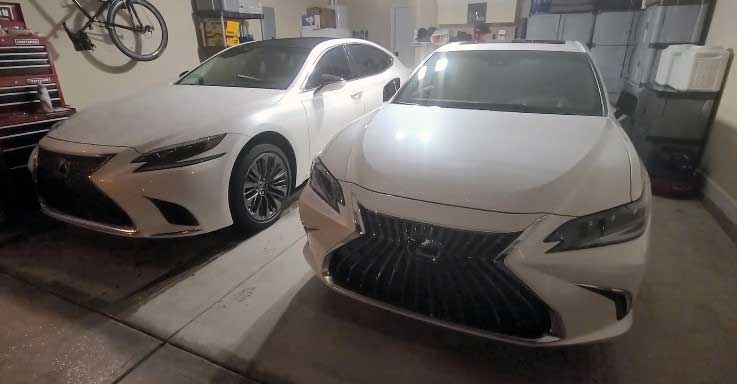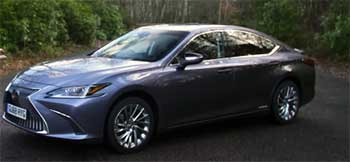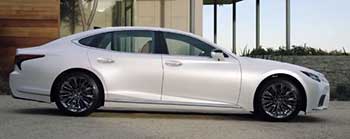As a car enthusiast who’s spent years behind the wheel of luxury sedans, I’m thrilled to share my take on two of Lexus’s finest: the ES and the LS. My goal here is to break down what makes these vehicles special. I will weigh their strengths and weaknesses to help you decide which one fits your lifestyle.
From performance to comfort, technology to price, I’ll explore every angle with a real-world perspective. I will use my time in the driver’s seat to guide you. By the end, you’ll have a clear picture of which sedan suits you best.

Comparison Table: Lexus ES vs Lexus LS
| Feature | Lexus ES | Lexus LS |
| Base Price (2025) | $43,190 | $80,685 |
| Engine Options | 2.5L Hybrid, 3.5L V6 | 3.5L V6 Hybrid, 3.4L Twin-Turbo V6 |
| Horsepower | 215 hp (Hybrid), 302 hp (V6) | 354 hp (Hybrid), 416 hp (V6) |
| Drivetrain | FWD, AWD (Hybrid) | RWD, AWD |
| Fuel Economy (Combined) | 26-30 MPG (V6), 44 MPG (Hybrid) | 22 MPG (V6), 26 MPG (Hybrid) |
| Interior Space | 99.9 cu. ft. passenger volume | 99.4 cu. ft. passenger volume |
| Trunk Space | 13.9 cu. ft. | 17.0 cu. ft. |
| Infotainment | 12.3-inch touchscreen, Lexus Interface | 12.3-inch touchscreen, Lexus Interface |
| Safety Features | Lexus Safety System+ 3.0 | Lexus Safety System+ 3.0, Teammate |
| Warranty | 4-yr/50,000-mi basic, 6-yr/70,000-mi powertrain | 4-yr/50,000-mi basic, 6-yr/70,000-mi powertrain |
My Journey with Luxury Sedans
I’ve always been drawn to the world of luxury sedans, where comfort meets performance in a way that makes every drive feel like an event. Growing up, I watched the automotive industry evolve, with brands like Lexus redefining what it means to blend sophistication with reliability. The Lexus ES and LS, in particular, caught my eye early on.
The ES, with its approachable elegance, seemed like the perfect entry into luxury. The LS, the brand’s flagship, promised a level of opulence reserved for those who demand the best. My time test-driving these cars, talking to owners, and analyzing their place in the market inspired this comparison. I’ve driven both, felt their differences, and now I’m here to share what I’ve learned about these two icons in Lexus’s lineup.
Lexus ES Overview
The Lexus ES has been a staple since 1989, designed as the approachable luxury sedan for those who want refinement without breaking the bank. My first drive in the 2025 ES 350 felt like slipping into a well-tailored suit—comfortable, polished, and just flashy enough to turn heads. It’s built on a platform shared with the Toyota Avalon, which gives it a smooth, predictable ride.
The ES offers two powertrains: a 2.5-liter hybrid with 215 horsepower and a 3.5-liter V6 pumping out 302 horsepower. Both pair with an 8-speed automatic, and the hybrid’s 44 mpg combined is a standout for eco-conscious buyers.

The interior is where the ES shines. I sank into its plush leather seats, surrounded by soft-touch materials and California walnut trim.
The 12.3-inch touchscreen, running Lexus’s Interface system, was intuitive, with wireless Apple CarPlay and Android Auto making connectivity a breeze. The cabin is whisper-quiet, perfect for long highway drives.
Safety-wise, Lexus Safety System+ 3.0 includes adaptive cruise control, lane-keeping assist, and pedestrian detection, keeping me confident in tricky traffic. But the ES isn’t perfect. Its front-wheel-drive layout (AWD optional on the hybrid) lacks the dynamic edge of rear-wheel-drive competitors like the BMW 5 Series. The handling, while competent, feels more floaty than sporty, and the V6, though powerful, doesn’t deliver the visceral thrill of a turbocharged engine. If you’re after a driver’s car, the ES might leave you wanting more.
Pros of Lexus ES
- Affordability: Starting at $43,190, the ES is a steal for a luxury sedan, offering premium features at a lower price point than competitors.
- Fuel Efficiency: The hybrid’s 44 mpg combined is a game-changer for those looking to save at the pump without sacrificing luxury.
- Comfort: The plush interior and quiet cabin make every drive a relaxing experience, perfect for commuters or long-distance travelers.
- Reliability: Lexus’s reputation for bulletproof engineering means the ES is likely to outlast many rivals, backed by a 6-year/70,000-mile powertrain warranty.
- Safety: Lexus Safety System+ 3.0 provides cutting-edge driver aids, giving peace of mind in all conditions.
Cons of Lexus ES
- Driving Dynamics: The ES’s soft suspension and front-wheel-drive setup don’t inspire confidence on twisty roads.
- Performance: The V6 is smooth but lacks the punch of turbocharged engines in competitors like the Audi A6.
- Limited Cargo Space: At 13.9 cubic feet, the trunk is smaller than the LS and some rivals, which could be a dealbreaker for frequent travelers.
Lexus LS Overview
The Lexus LS, the brand’s flagship since its debut in 1989, is a statement of luxury and ambition. My time in the 2025 LS 500 was nothing short of regal. It’s a car that commands attention, with a bold spindle grille and sleek proportions. The LS offers a 3.4-liter twin-turbo V6 with 416 horsepower or a 3.5-liter V6 hybrid with 354 horsepower, both paired with a 10-speed automatic. Rear-wheel drive is standard, with AWD available for extra grip.

Inside, the LS is a masterpiece. The 28-way power-adjustable seats with massage functions felt like a first-class cabin, and the optional Kiriko glass trim added a touch of artistry.
The 12.3-inch touchscreen mirrors the ES’s setup, but the LS adds the Teammate system, offering semi-autonomous driving features. The ride is buttery smooth, absorbing bumps with ease, and the cabin’s soundproofing makes it a sanctuary from the outside world.
However, the LS has its downsides. Its starting price, nearly double the ES’s, is a tough pill to swallow. The hybrid’s 26 mpg combined lags behind the ES, and the infotainment, while advanced, can feel cluttered compared to rivals like the Mercedes S-Class. The LS also lacks the razor-sharp handling of a BMW 7 Series, prioritizing comfort over agility.
Pros of Lexus LS
- Luxury: The LS’s interior, with options like semi-aniline leather and Kiriko glass, feels like a private jet, elevating every journey.
- Power: The twin-turbo V6’s 416 horsepower delivers effortless acceleration, making highway merging a breeze.
- Technology: The Teammate system and advanced safety features push the LS into semi-autonomous territory, a step ahead of the ES.
- Spaciousness: With 17 cubic feet of trunk space and generous rear legroom, the LS is ideal for families or chauffeured duties.
- Prestige: As Lexus’s flagship, the LS carries a level of status that the ES can’t match, perfect for those who want to stand out.
Cons of Lexus LS
- Price: Starting at $80,685, the LS is significantly more expensive, making it less accessible for budget-conscious buyers.
- Fuel Economy: The hybrid’s 26 mpg combined is disappointing for a modern luxury sedan, trailing competitors like the BMW 7 Series hybrid.
- Infotainment Complexity: The touchscreen interface, while feature-rich, can be overwhelming compared to sleeker systems in rival sedans.
- Driving Dynamics: Prioritizes comfort over agility, less sharp than some competitors.
Performance Comparison
When I floored the ES 350’s V6, it delivered a respectable 0-60 mph time of about 6.6 seconds. It felt smooth and composed but not exhilarating. The hybrid, while efficient, felt sluggish at times, better suited for city cruising than spirited drives.
The LS 500, on the other hand, was a revelation. Its twin-turbo V6 hit 60 mph in around 5.4 seconds, with a satisfying surge of power that made passing slower traffic effortless. The hybrid LS, while slightly slower, offered instant torque from its electric motor, adding a unique flavor to the drive.
Handling is where the ES and LS diverge further. The ES’s front-wheel-drive platform (even with AWD) feels planted but lacks the precision of rear-wheel-drive sedans. I noticed some body roll in corners, which didn’t inspire confidence.
The LS, with its rear-wheel-drive setup and optional air suspension, felt more balanced. It soaked up imperfections while maintaining composure on winding roads. However, it’s not a sports sedan—don’t expect BMW M5 levels of agility.
Interior and Comfort Comparison
Stepping into the ES, I was greeted by a cozy, well-crafted cabin. The seats were supportive, and the layout was intuitive, with physical buttons for climate control complementing the touchscreen. The rear seats offered ample legroom for my 6-foot frame, though headroom was snug for taller passengers.
The LS, however, took luxury to another level. The rear seats, with optional reclining and massage functions, felt like a private lounge. The attention to detail, from the hand-stitched leather to the ambient lighting, made every drive feel special. But the ES’s simpler design made it easier to live with daily, while the LS’s opulence sometimes felt like overkill for solo commutes.
Technology and Safety Comparison
Both sedans come equipped with Lexus’s Interface system, featuring a 12.3-inch touchscreen, wireless smartphone integration, and voice-activated controls. I found the ES’s system responsive and user-friendly, though it lacks the LS’s advanced Teammate suite, which includes hands-free driving in certain conditions.
Safety is a strong suit for both, with Lexus Safety System+ 3.0 offering adaptive cruise control, lane-centering, and automatic emergency braking. The LS’s additional features, like enhanced pedestrian detection and intersection assist, give it a slight edge, but the ES holds its own for most drivers.
Discover More: Lexus IS 350 vs. IS 500
Price and Value Comparison
The ES’s starting price of $43,190 makes it a compelling value. You get near-flagship luxury for thousands less than competitors like the Mercedes E-Class ($56,000+). The LS, at $80,685, competes with heavyweights like the BMW 7 Series and Mercedes S-Class, but its price can climb past $100,000 with options. For me, the ES delivered 80% of the LS’s luxury at half the cost, making it the better deal for budget-conscious buyers. However, the LS’s prestige and advanced tech justify the premium for those who can afford it.
Real-World Driving Experience
Driving the ES through city streets, I appreciated its smooth ride and quiet cabin, perfect for navigating rush-hour traffic. On highways, the hybrid’s fuel efficiency shone, letting me cover long distances without frequent stops. The LS, however, was my choice for special occasions. Its commanding presence and powerful engine made weekend getaways feel like events, though I winced at the fuel pump. Both cars excel in comfort, but the ES is the practical daily driver, while the LS is the indulgent splurge.
Who Should Buy the Lexus ES?
The ES is for buyers like me who want luxury without the hefty price tag. It’s ideal for commuters, families, or anyone prioritizing fuel efficiency and reliability. If you value a quiet, comfortable ride and don’t need blistering performance, the ES delivers. It’s also a great choice for those new to the luxury market, offering premium features at an accessible price.
Who Should Buy the Lexus LS?
The LS is for those who crave the ultimate Lexus experience. If you’re a business professional, car enthusiast, or someone who loves cutting-edge tech and opulent interiors, the LS is worth the investment. It’s perfect for long-distance cruisers or those who want a car that doubles as a status symbol. Just be prepared for the higher cost and lower fuel economy.
Also Read: Lincoln Continental vs. Lincoln MKZ
Frequently Asked Questions
The LS is the better choice if you prioritize luxury, space, and advanced tech, but the IS is sportier and more affordable, ideal for those wanting a dynamic drive on a budget.
The LS is significantly more expensive, starting at $80,685, compared to the ES’s $43,190.
No, but it shares a platform with the Toyota Avalon and Camry. The ES offers superior luxury, refinement, and features, setting it apart from its Toyota cousins.
Conclusion
After spending time with both the Lexus ES and LS, I can say they’re two sides of the same coin—each offering a unique take on luxury. The ES won me over with its value and efficiency, perfect for everyday driving without sacrificing comfort. The LS, though, stole my heart with its grandeur and power, a true flagship for those who want the best. Your choice depends on your priorities: affordability or opulence, practicality or prestige. Whichever you pick, Lexus delivers a driving experience that’s tough to beat. So, which one’s calling your name?

